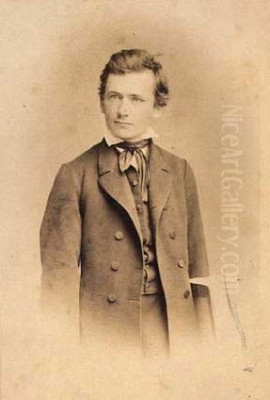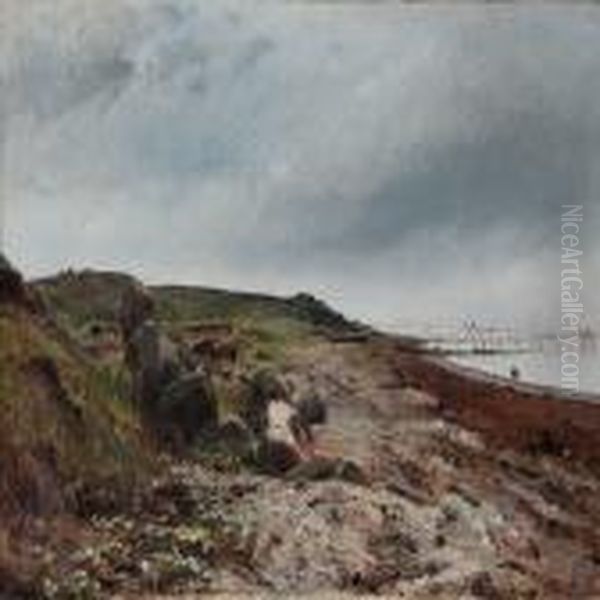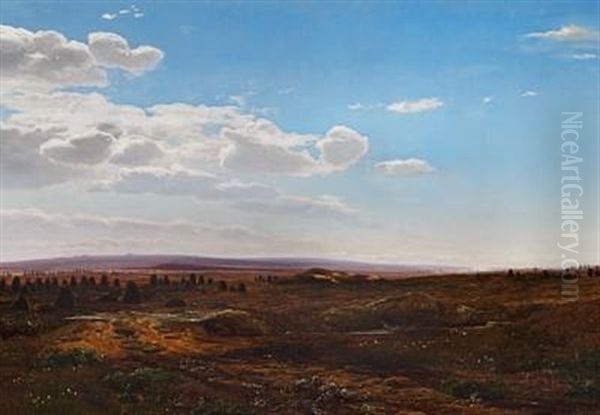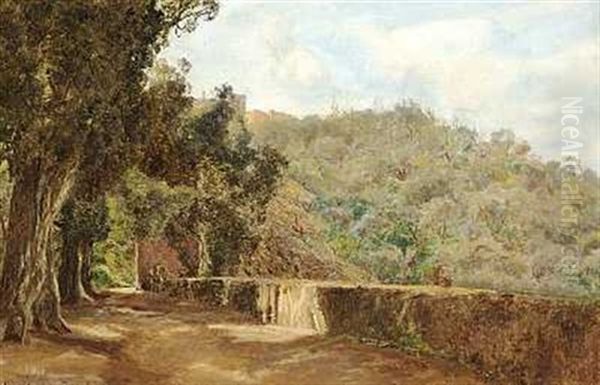
Janus Andreas Bartholin la Cour (1837-1909) stands as a significant figure in the landscape painting tradition of Denmark, particularly bridging the late Golden Age with the modern movements emerging at the turn of the 20th century. A meticulous observer of nature, La Cour dedicated his career to capturing the subtle beauties and serene moods of the Danish countryside and coastlines, as well as scenes from his travels abroad. His work is characterized by its quiet intensity, refined technique, and profound connection to the natural world, earning him respect and recognition both during his lifetime and posthumously.
Early Life and Artistic Formation
Born on September 5, 1837, at the Thimgård farm near Ringkøbing in West Jutland, Janus la Cour's upbringing was deeply immersed in the landscapes that would later dominate his canvases. The expansive vistas, the dramatic coastline, and the unique quality of light in western Denmark left an indelible mark on the young boy. From an early age, he displayed a natural inclination towards art, finding joy in sketching the scenes around him – the rising sun, the moonlit nights, and the ever-present sea meeting the shore. His family recognized his talent, fostering his artistic pursuits.
Formal art education began around the age of 13 or 14. Sources mention early instruction under figures like Hans Egede-Holst (sometimes referred to as E.L-H. Goghehding in variations), who taught him fundamental drawing and oil painting techniques. He attended Askov Højskole, a folk high school known for its cultural education. Seeking more advanced training, La Cour moved to Copenhagen in 1855. Initially, he studied briefly under Wilhelm Marstrand, a prominent historical and genre painter of the Danish Golden Age. However, a more formative relationship began in 1856 when he became a student of P.C. Skovgaard.

Peter Christian Skovgaard (1817-1875) was himself a leading landscape painter, renowned for his depictions of Danish beech forests and national romantic scenes. Skovgaard's influence on La Cour was profound and lasting. More than just a teacher, Skovgaard became a mentor and close personal friend. While La Cour absorbed technical skills and a deep appreciation for the Danish landscape tradition from Skovgaard, he gradually developed his own distinct artistic voice, moving towards a more objective, yet deeply felt, rendering of nature. He also attended the drawing school run by Frederik Christian Kiærskou, another contemporary landscape painter, further honing his foundational skills.
Developing a Distinctive Style
La Cour made his public debut relatively early. In 1853, while still a teenager, he exhibited a work titled Strandparti fra Helgenæs (Beach Scene from Helgenæs) in Copenhagen, which garnered positive attention. This early success encouraged him to further explore the coastal regions of Jutland, particularly the western shores he knew from childhood. These formative years were crucial in establishing his preference for tranquil, often solitary, natural scenes. He became particularly adept at capturing the specific atmospheric conditions of the Danish landscape – the soft light of dawn, the hazy horizons over the sea, and the quiet stillness of rural life.
His dedication and talent were recognized early on. In 1861, La Cour received the prestigious Neuhausen Prize for his painting Tidlig Sommermorgen ud over en Eng (Early Summer Morning Across a Meadow). This award marked an important milestone, solidifying his position as a promising young artist within the Copenhagen art scene. His style during this period, while indebted to the Golden Age tradition exemplified by figures like C.W. Eckersberg (the foundational figure whose emphasis on direct observation and clear composition influenced generations, including Skovgaard and thus La Cour), began to show a unique sensitivity to light and texture that would become his hallmark.
La Cour's approach was rooted in careful observation. He spent considerable time outdoors, sketching and studying the nuances of light, weather, and terrain. Unlike some of his contemporaries who might have leaned more heavily towards national romanticism, La Cour's work often possessed a more objective, almost meditative quality. He was less concerned with grand narratives and more focused on the intrinsic beauty and quiet dignity of the landscape itself. His paintings from this era often depict calm coastal stretches, reflective waters, and the subtle interplay of light and shadow across fields and forests.
Travels and Broadening Horizons

A pivotal moment in La Cour's artistic development came in 1865 when he was awarded a travel scholarship from the Royal Danish Academy of Fine Arts. This enabled him to embark on an extended journey abroad, visiting France, Switzerland, and, significantly, Italy. Like many Northern European artists before him, including the sculptor Bertel Thorvaldsen and Golden Age painters such as Christen Købke and Constantin Hansen, the journey south offered new motifs, different light conditions, and exposure to diverse artistic currents. He spent time in Rome and its environs, as well as visiting Genoa.
This period of travel, lasting until 1867, had a noticeable impact on his work. Exposure to contemporary European art, particularly in France, subtly influenced his approach. While the source material mentions "French Neo-Impressionism," it's perhaps more accurate to consider the broader impact of French Realism and the burgeoning Impressionist movement's focus on light and plein-air painting. La Cour's palette may have brightened somewhat, and his interest in capturing transient effects of light intensified, although he never fully abandoned the meticulous detail and structured composition rooted in his Danish training.
His time in Italy resulted in several significant works depicting Mediterranean landscapes. En aftenstund ved Nemisøen (An Evening Hour by Lake Nemi), painted in 1866, captures a serene moment near the Alban Hills outside Rome, showcasing his ability to apply his sensitive style to foreign scenery. Another notable Italian subject is Torre di Schiavi, depicting a view across the Roman Campagna towards the ancient ruins. These works demonstrate his versatility and his keen eye for capturing the unique atmosphere of different locales, while retaining his characteristic sense of calm and compositional harmony. The experience abroad broadened his thematic range and likely reinforced his commitment to landscape as his primary mode of expression.
Mature Career and Recognition
Upon returning to Denmark, La Cour continued to refine his art. He received further accolades, including the Sødrigens Opmuntringspræmie (Encouragement Prize) in 1867. He became an established figure, regularly exhibiting his work. His paintings were sought after for their technical skill and their evocative portrayal of Danish nature. He was eventually awarded the prestigious Thorvaldsen Medal in 1871, the highest honor bestowed by the Royal Danish Academy of Fine Arts, signifying his esteemed position within the Danish art world. Later, he was also appointed a Knight of the Order of the Dannebrog, a significant civil honor.

In 1886, seeking tranquility and perhaps distance from the bustling Copenhagen art scene, La Cour settled in Mariendal, near Aarhus in East Jutland. This move marked a shift in his focus towards the landscapes of this region. He lived a relatively secluded life, dedicating himself to his painting. His works from this period often depict the gentle hills, forests, and coastal areas of East Jutland, imbued with his signature quietude and meticulous attention to detail. He seemed to find endless inspiration in the subtle shifts of seasons and the interplay of light on the familiar terrain.
Key works from his mature period include Forladt Baad paa Stranden (Abandoned Boat on the Beach) from 1886. This painting exemplifies his ability to convey mood through landscape, using cool tones and a sense of desolation to depict a solitary boat on an empty shore. Another significant later work is Septemberstrand (September Beach) from 1904, a large oil painting capturing the specific light and atmosphere of the coast in early autumn. He also produced notable winter scenes, such as Landsbyen. Vinterdag med klart Frost (The Village. Winter Day with Clear Frost) and Ved Vintertid udenfor en Bondegaard (Winter Time Outside a Farm), both from 1888, which were later featured in a retrospective exhibition in Aarhus.
His works became part of important collections, including the Statens Museum for Kunst (National Gallery of Denmark) in Copenhagen, ensuring his legacy. He continued to paint until his death in 1909, leaving behind a substantial oeuvre that consistently explored the nuances of the Danish landscape.
Artistic Style and Themes
Janus la Cour's artistic style is best described as a form of lyrical realism, deeply rooted in the observational tradition of the Danish Golden Age but infused with a personal, almost spiritual sensitivity to nature. His connection to the Eckersberg school is evident in the clarity of his compositions, the precision of his drawing, and his commitment to depicting what he saw accurately. However, La Cour transcended mere topographical representation; his primary aim was to capture the mood and atmosphere of a place, often emphasizing moments of stillness and solitude.
Light was a central element in his work. He masterfully rendered the subtle variations of daylight – the cool, clear light of morning, the warm glow of late afternoon, the diffused light of an overcast day, or the stark contrasts of winter frost. His paintings often feature calm bodies of water – seas, lakes, or streams – allowing him to explore the complex effects of reflection and transparency. A recurring theme noted in the source material is the depiction of streams meeting the sea, perhaps symbolizing a connection between the intimate and the vast.
His technique was meticulous. He applied paint smoothly, often in thin layers, achieving fine detail without sacrificing the overall atmospheric unity of the scene. His palette, while capable of richness, often favored subtle harmonies and tonal gradations, contributing to the serene and contemplative quality of his work. While aware of contemporary French movements like Impressionism, possibly influencing his heightened attention to light effects (perhaps akin to the atmospheric concerns of artists like Claude Monet or Camille Pissarro, though stylistically very different), La Cour remained fundamentally tied to the Danish landscape tradition. He did not adopt the broken brushwork or vibrant chromaticism of the French Impressionists, instead maintaining a more polished finish and a structured sense of form.
Compared to his teacher P.C. Skovgaard, whose works often carry a stronger sense of national romanticism and sometimes a more dramatic mood, La Cour's paintings generally exude a greater sense of peace and objective observation. The source material suggests La Cour developed a focus on "energy and form study" that distinguished him from Skovgaard's emphasis on mood. Compared to F.C. Kiærskou, known for his detailed, sometimes panoramic views often of Swedish landscapes, La Cour's focus remained primarily on the Danish environment (with exceptions during his travels), and his handling of light and atmosphere arguably possessed a more poetic and introspective quality.
Relationships with Contemporaries
La Cour's artistic journey unfolded during a dynamic period in Danish art. While deeply influenced by his teacher P.C. Skovgaard, their relationship evolved into a lasting personal friendship, providing La Cour with crucial support and intellectual companionship. This connection anchored him firmly within the established landscape tradition.
His relationship with other artists appears to have been characterized more by collegiality and context than by overt rivalry. The source material explicitly states there is no clear information about specific competitive relationships. However, he naturally operated within a field populated by talented peers. The Skagen Painters, including figures like P.S. Krøyer, Michael Ancher, and Anna Ancher, were gaining prominence during the later part of La Cour's career, bringing a different, often brighter and more socially engaged, perspective to Danish landscape and coastal scenes. While La Cour's quieter, more solitary style differed significantly from the Skagen school's vibrancy, they shared a common dedication to depicting Danish light and life.
Interestingly, the source mentions a collaboration with the French painter Eugène Galien-Laloue (1854-1941), known for his Parisian street scenes. They reportedly collaborated on a work titled Fra Villa d’Este. While the specifics (like the erroneous 1837 date mentioned in one source context) require careful consideration, the existence of such a collaboration points to La Cour's engagement with the wider European art world beyond his Danish roots.
His decision to move away from Copenhagen to Mariendal in 1886 suggests a preference for a more secluded artistic life, perhaps distancing himself from the pressures and politics of the capital's art scene. His unique surname, "La Cour," which has historical resonance and was subject to genealogical study (work he himself contributed to in 1903 by compiling a family record), might have subtly influenced his social standing, but his reputation rested firmly on the merit of his art.
Legacy and Conclusion
Janus la Cour passed away in 1909, leaving behind a legacy as one of Denmark's most sensitive and dedicated landscape painters. His art represents a continuation and refinement of the Golden Age tradition of close natural observation, combined with a distinctly personal, meditative quality. He excelled at capturing the quiet beauty and specific atmosphere of the Danish landscape, particularly its coasts and rural interiors. His meticulous technique, mastery of light, and ability to evoke profound stillness and peace remain hallmarks of his work.
While perhaps less dramatic or overtly innovative than some of his contemporaries, La Cour's consistent dedication to his vision produced an oeuvre of remarkable coherence and quality. His paintings offer viewers moments of quiet contemplation, inviting them into serene natural worlds rendered with both precision and poetry. His work continues to be appreciated for its technical excellence and its timeless depiction of the Danish environment.
Beyond his painting, his contribution to recording his family's genealogy provides a small but interesting footnote to his life, reflecting a sense of history and lineage. Primarily, however, Janus la Cour is remembered as the painter of tranquil shores, reflective waters, and silent forests – an artist who found enduring beauty in the understated landscapes of his homeland and conveyed it with quiet mastery. His works remain treasured in collections like the Statens Museum for Kunst and continue to resonate with audiences appreciative of subtle, atmospheric landscape painting.